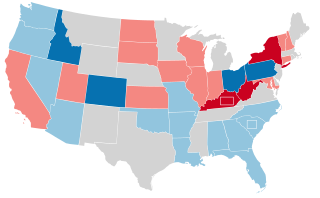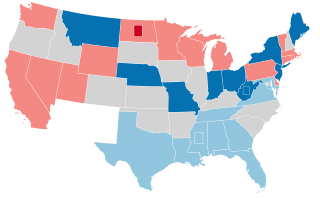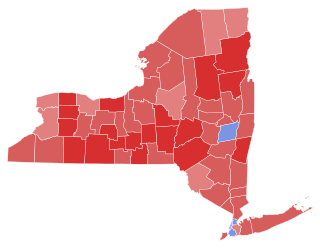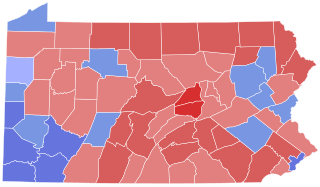
James Henderson "Jim" Duff was an American lawyer and politician. A member of the Republican Party, he served as United States Senator from Pennsylvania from 1951 to 1957. Previously he had served as the 34th Governor of Pennsylvania from 1947 to 1951.

The 1956 United States Senate elections were elections for the United States Senate that coincided with the re-election of President Dwight D. Eisenhower. Although Democrats gained two seats in regular elections, the Republicans gained two seats in special elections, leaving the party balance of the chamber unchanged.

The 1950 United States Senate elections occurred in the middle of Harry S. Truman's second term as President. As with most 20th-century second-term mid-terms, the party not holding the Presidency made significant gains. The Republican opposition made a net gain of five seats, taking advantage of the Democratic administration's declining popularity during the Cold War and the aftermath of the Recession of 1949. The Democrats held a narrow 49-to-47-seat majority after the election. This was the first time since 1932 that the Senate Majority Leader lost his seat, and the only instance of the majority leader losing his seat while his party retained the majority.

The 1944 United States Senate elections coincided with the re-election of Franklin D. Roosevelt to his fourth term as President. The Democrats retained their large majority, although they lost a net of one seat to the Republicans.

Francis John Myers was an American teacher, lawyer, and Democratic Party politician. He represented most of West Philadelphia and Southwest Philadelphia in the United States House of Representatives from 1939 to 1945 and represented Pennsylvania in the United States Senate for one term from 1945 to 1951. He was Senate Majority Whip from 1949 to 1951.

The 1910 and 1911 United States Senate election, although the 17th Amendment was not passed until 1913, some states elected their senators directly before its passage. Oregon pioneered direct election and experimented with different measures over several years until it succeeded in 1907. Soon after, Nebraska followed suit and laid the foundation for other states to adopt measures reflecting the people's will. By 1912, as many as 29 states elected senators either as nominees of their party's primary or in conjunction with a general election.

The 1950 New York state election was held on November 7, 1950, to elect the governor, the lieutenant governor, the state comptroller, the attorney general and a U.S. Senator, as well as all members of the New York State Assembly and the New York State Senate.

The 1980 United States Senate election in Pennsylvania was held on November 4, 1980. Incumbent Republican U.S. Senator Richard Schweiker decided to retire, instead of seeking a third term. Republican nominee Arlen Specter won the open seat, defeating Democratic nominee Peter F. Flaherty. As of 2022, this is the last time Philadelphia voted for a Republican statewide candidate. This is also the last Senate election where Butler County, Clarion County, Venango County, and Jefferson County voted Democratic.

The 1944 United States Senate election in Pennsylvania was held on November 7, 1944. Incumbent Republican U.S. Senator James J. Davis sought re-election, but was defeated by Democratic nominee Francis J. Myers.

The 1932 United States Senate election in Pennsylvania was held on November 8, 1932. Incumbent Republican U.S. Senator James J. Davis successfully sought re-election, defeating Democratic nominee Lawrence H. Rupp.

The 1962 United States Senate election in Pennsylvania was held on November 6, 1962. Incumbent Democratic U.S. Senator Joseph S. Clark, Jr. successfully sought re-election to another term, defeating Republican nominee James E. Van Zandt.

The 1956 United States Senate election in Pennsylvania was held on November 6, 1956. Incumbent Republican U.S. Senator James H. Duff sought re-election to another term, but was defeated by the Democratic nominee, Joseph S. Clark, Jr.

The 1930 United States Senate special election in Pennsylvania was held on November 4, 1930. Joseph R. Grundy, incumbent Republican appointed to fill the vacancy created by the unseating of William Scott Vare, was defeated for re-nomination. The Republican nominee, James J. Davis, defeated Democratic nominee Sedgwick Kistler to win the election.

The 1938 United States Senate election in Pennsylvania was held on November 8, 1938. Incumbent Republican U.S. Senator James J. Davis was re-elected to a second term in office over Democratic Governor George Howard Earle III.

The 1982 United States Senate election in Pennsylvania was held on November 2, 1982. Incumbent Republican U.S. Senator John Heinz successfully sought re-election to another term, defeating Democratic nominee Cyril Wecht.

The 1914 United States Senate election in California was held on November 6, 1914. Incumbent Republican Senator George Clement Perkins did not run for re-election.

The 1950 United States Senate election in Iowa took place on November 7, 1950. Incumbent Republican Senator Bourke B. Hickenlooper was re-elected to a second term in office over Democratic U.S. Undersecertary of Agriculture Albert J. Loveland.

A Massachusetts general election was held on November 6, 1956, in the Commonwealth of Massachusetts.

A Massachusetts general election was held on November 2, 1954 in the Commonwealth of Massachusetts.

The 1946 Massachusetts general election was held on November 5, 1946, throughout Massachusetts. Primary elections took place on June 18.





















